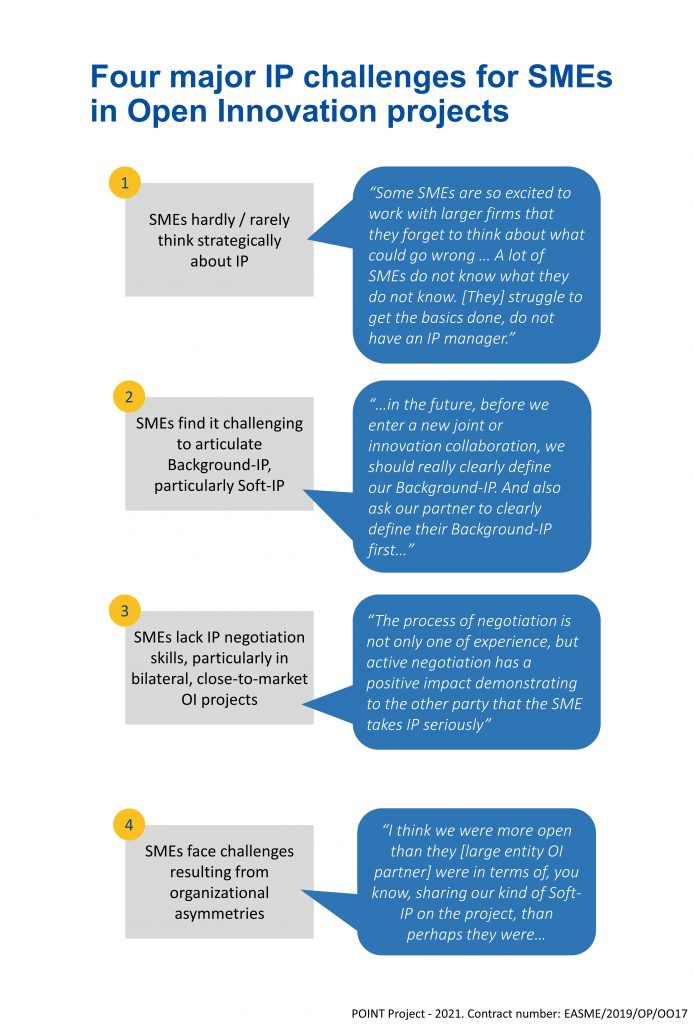
IP in many forms is a key enabler of collaboration
Small and medium-sized enterprises (SMEs) are considered to be the engine of the European economy. After an official commitment to OI in 2016, the Commission continues to promote OI as part of its digital single market and innovation policies. Particularly for SMEs working on key enabling technologies, their Hard-Intellectual Property (Hard-IP) e.g. patents, trademarks, but often more so their Soft-IP e.g. data, know-how, represents a considerable value to their business. However, a large share of SMEs still lacks awareness and understanding of IP, not least to effectively appropriate the benefits of OI.
A study was commissioned in 2020 to provide an empirical basis for existing OI models and the extent to which IP – including patents, utility models, designs, but also trade secrets, data and know-how – facilitates or hinders OI, with a particular focus on SMEs.
The study was based on 40 case studies (mostly with SMEs, but also large firms, higher education institutions (HEI) and public research organisations (PRO)) from seven value chains across Europe, Australia, India, Israel, UK and US, and input from a wide range of experts.
Challenges with IP issues during Open Innovation projects
It is clear from these case studies that IP in many forms is a key enabler of collaboration. SMEs seek to share and gain access to different forms of IP through collaboration to pursue their business goals. While the forms of IP may differ, the study did not find evidence that IP acts as a barrier to collaboration. What the data shows is that SMEs face challenges when dealing with IP issues during Open Innovation projects.

SMEs face four challenges associated with OI projects:
- SMEs hardly think strategically about IP: The evidence reveals that the SMEs we interviewed understand some ‘IP essentials’, but lack in-house expertise/experience in managing IP strategically. The lack of a strategic understanding of IP causes challenges, for instance, when negotiating collaboration agreements not only with other SMEs, but particularly with partners that are organisationally different, such as large firms and HEIs. These partners typically have established in-house IP expertise, such as dedicated IP counsels/departments in the case of large firms and Technology Transfer Offices (TTOs) in the case of HEIs. While there are options for SMEs to access external IP expertise, existing IP experts are mostly ‘IP specialists’ focused on particular types of IP, e.g. patents.
- SMEs find it challenging to articulate/specify Background-IP, particularly Soft-IP: Many SMEs recognise difficulties of identifying relevant Background-IP, and the risks of getting this wrong or the risk of this being claimed by an OI partner as Foreground-IP during an OI project, if not clearly identified and captured before the project start. SMEs also report that while Hard-IP can be more clearly identified and demarcated before and while engaging in OI projects, SMEs have more difficulties identifying and clearly defining/articulating Soft-IP.
- SMEs lack IP negotiation skills, particularly in bilateral, high-risk-high-reward OI projects: SMEs mentioned weaknesses related to lack of contract negotiation skills, particularly the inexperience with IP risk assessments, agreeing upon the terms to own and share Foreground-IP and the lack of experience with dividing responsibilities amongst OI partners. Evidence shows that SMEs engage in OI projects at all stages, i.e. all the way along the development life cycle from low to high Technology Readiness Levels (TRL). Typically, when SMEs engage in bilateral OI projects, these tend to be in higher TRLs than consortia projects. It is bilateral, close-to-market projects, often with larger partners, that present high commercial risks to SMEs, for which prior IP experience appears to be critical.
- SMEs face challenges because of organisational asymmetries: Organisational asymmetries emerge as the biggest challenge overall, showing up to be problematic in over one third of the case studies. Organisational asymmetries are reported to occur due to strategic misalignment between OI partners; differences in culture and mindset due to varying IP openness; difference in approaches to contract formality; overall pace of progress; and risk tolerance.
For anyone involved in supporting SMEs with collaborative projects, Open Innovation or general IP support, this report should be essential reading.
Further details and a downloadable copy of the report can be found at: https://op.europa.eu/en/publication-detail/-/publication/3e42e795-353a-11ec-bd8e-01aa75ed71a1
For more information about our IP Strategy service, or to discuss how Cubicibuc can help your organisation please contact us.
